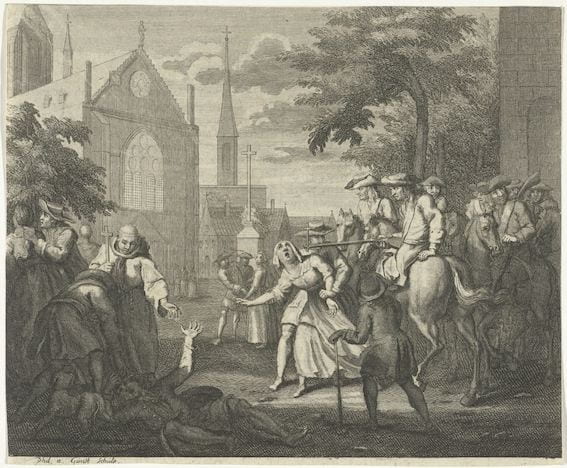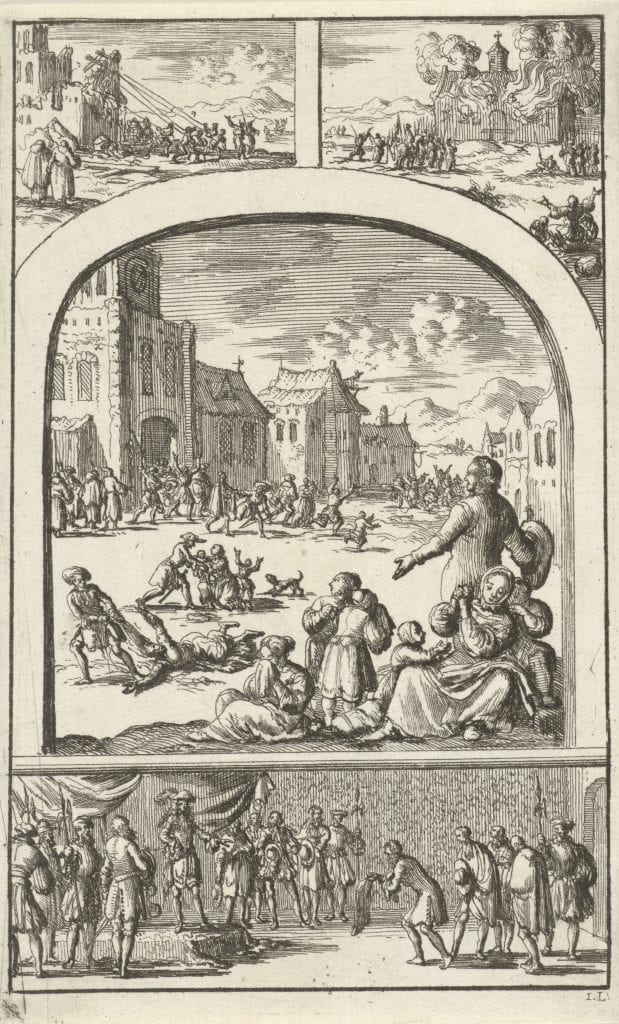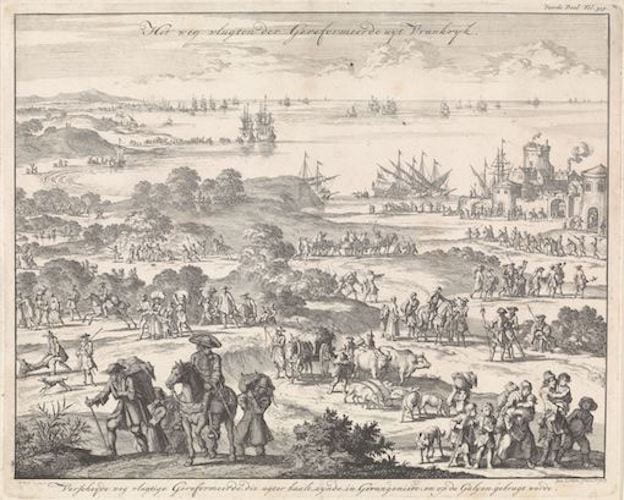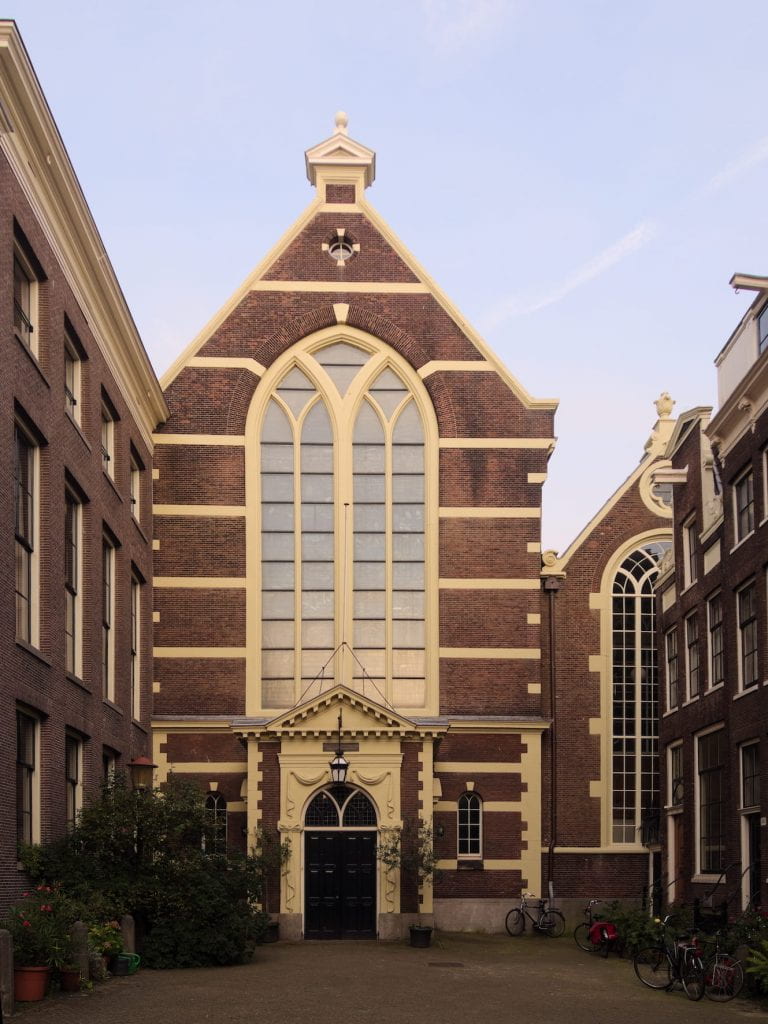By Lotte van Hasselt
In the spring of 1688, an important newspaper in the Dutch Republic reported that a group of six to eight men and women “who had impersonated French refugees” were sentenced to walk through the streets of The Hague until they were standing outside the city gates. The whole time, they were carrying a sheet of paper on the front and back of their body, reading: “valsche vluchtelingen” or “false refugees”.
Who were these ‘false’ refugees? And if these people were ‘false’ refugees, who were the ‘true’ refugees? I will try to answer these questions by examining events that took place in the years preceding 1688. During this tumultuous time, a large number of French Protestants, also known as Huguenots, fled France and settled in the Dutch Republic. In the process of deciding who deserved support and administering charity, a growing concern emerged around the idea of the ‘true’ refugee.
Since the 1660s, the Catholic king of France, Louis XIV (1643-1715) had increasingly aimed for unity in his realm, including religious unity. As a result, French Protestants, who had formed an important minority in France since the Reformation, were more and more constrained in their religious and public life. Their oppression culminated in the Revocation of the Edict of Nantes in 1685.
The Revocation meant that Protestants could no longer attend Protestant services, their ministers had to leave France within fourteen days, all Protestants schools and churches were to be closed or destroyed, and emigration was prohibited for lay Protestants. Despite the prohibition on leaving, many Huguenots fled France to neighbouring Protestant countries, including the Dutch Republic.

To begin with, towns and provinces in the Dutch Republic, as elsewhere in Europe, were interested in attracting uprooted French refugees. This hospitable attitude seems to have derived principally from the expectation that refugees would benefit the local economy. In the Dutch Republic, many towns, among them Rotterdam, Middelburg, Leiden, Groningen and Amsterdam promised extensive privileges to French refugees if they settled in their town.These privileges usually included free citizenship, free admission to the guilds or permission to work outside them, and exemption from certain city taxes.
Many towns publicly advertised privileges they granted to the French refugees. Leiden and Middelburg, for example, announced them in the Gazette de Leyde. Newspapers in French published in the Dutch Republic were smuggled to France where they reached their intended audience. In 1686, the provincial authorities of Groningen also promoted the benefits of settling in the region by highlighting the healthy air, fertile soil and favourable location of the town near rivers.
To make sure that the French refugees knew about these benefits, the province printed five hundred copies in French and send them to Tjaert Gerlacius (1628-1694), deputy of Groningen at the Dutch States General (the States General was an assembly of delegates from the seven provincial states). Gerlacius was to distribute newspapers among French refugees who often arrived in the western provinces of the Dutch Republic. With these advertisements, towns hoped to attract French craftsmen who could boost local industries, such as textile manufacturing.
The expected place of French Protestants in Dutch society was evaluated in terms of how they met economic needs of provincial and municipal governments. However, their economic value was not the sole motive for granting privileges to the Huguenots. In the announcements of extended privileges, town councils imposed specific criteria on who could claim these privileges. Most criteria did not reflect economic expectations about the Huguenots; instead, they were mostly concerned with the Huguenot’s predicament as persecuted, displaced, and Reformed.
That the recipient should be Reformed is not surprising. Reformed Protestantism was the official public religion in the Dutch Republic at the time. Other confessions were tolerated as long as they did not worship publicly. The Reformed identity of the French refugees also related to other criteria for privileges. The Huguenots fled France because of religious persecutions and, in the eyes of the Reformed community in the Dutch Republic, had suffered for the “true” faith. According to town councils and provincial states, the persecution and subsequent displacement of the Huguenots was a sign of steadfastness and loyalty to the Reformed church, making privileges and charity a reasonable response.

The criteria set by town councils reveal historical conceptions of what a ‘true’ refugee supposed to be. This definition is illustrated by a disagreement in Groningen between the surgeons’ guild and the town council regarding privileges for the French Protestants. In 1682, the guild complained to the council about the large number of surgeons present in Groningen, caused by the influx of French refugees who were able to practice without being a member of the guild. The town council argued that in this case it was not against regulations, because the “foreigners” were “persecuted because of their religion.” Thereby, the town council asserted that one of the reasons the Huguenots deserved and could claim support, was because they had been persecuted.
In other meeting minutes, which record the decision-making process of town councils, as well as in requests for privileges by the Huguenots themselves, these criteria were further defined. Recurrent themes in discussions around privileges for the French refugees were the persecution in France, the hardships during their flight, the abandonment of all their possessions in France, and their loyalty to the Reformed Protestant faith.These descriptions of the Huguenots’ plight indicate who was eligible for these privileges and ‘deserved’ charity—and who did not.
These considerations are further explicated in a pamphlet published by the town and province of Groningen in 1686. It is the same pamphlet in which the town promoted the benefits of settling in Groningen by describing the healthy air and fertile soil. It also outlined the privileges Groningen had granted to French refugees. The town council paid specific attention to those who, in their opinion, abused the charity extended to the Huguenots. They were especially concerned that Catholics would pose as Reformed refugees and would receive privileges they did not ‘deserve’.
To be sure that no Roman-Catholics, under the pretense of being Reformed refugees, will receive any money, the States of Groningen have agreed / that the refugees who will come to Groningen / will be examined and interrogated, and if it is found that someone uses the name of the Reformed refugees unjustly / will be punished as an example, to which end the States of Groningen have agreed and resolved and will make this known through publication / in order to make it known to everyone [author’s translation].
This pamphlet also shows how the organization of charity and privileges, especially for displaced people, emphasized religious demarcation lines and identities. The conception of ‘true’ refugees did not include Catholics in the eyes of the Reformed community. Notions around the concept of refugee were hence confessionally determined. The fear that the privileges would fall into the hands of ‘false’ refugees was also prompted by disappointment about the economic contributions of the Huguenots.
David van der Linden has argued in his 2016 book Experiencing Exile that many French refugees had difficulty making ends meet and had to rely on local poor relief. This situation made town councils even more alert to individuals who, according to them, unjustly claimed the extended privileges. The town council of Groningen stated that incoming refugees would be examined and questioned to make sure that nobody could pose as a Reformed refugee. Whoever pretended to be a Reformed refugee would be punished. The pamphlet does not state what kind of punishment the ‘false’ refugee had to expect. However, my initial example of publicly shaming ‘false’ refugees in The Hague provides an illustration of the kinds of punishment that could be imposed.
By combining the pamphlets, meeting minutes and correspondence of town councils and provincial states, a broader picture emerges of what was meant by ‘false’ refugees in the context of late seventeenth-century The Hague. The men and women who were led through the streets of this town, wearing a sign reading ‘false refugees’, did not meet the criteria set by town councils and provincial states, and were seen as having likely claimed charity unjustly. In the complex process of negotiating who deserved charity, a concept of ‘refugee’ was shaped. Discussions around privileges for the French Protestants in the Dutch Republic show that there was a relatively organized perception of religious persecution as a premise for helping displaced people.
This premise was the result of earlier migrations and refugee communities in the Dutch Republic, which shaped narratives around Reformed exile. Persecution and displacement triggered the need for asylum, protection and support. In the process of administering and negotiating who could claim these categories, concepts of ‘true’ or ‘deserving’ versus ‘false’ or ‘undeserving’ refugees materialized. As such, the ‘false’ refugees in Dutch Republic emerges as a complex case-study, which prefigures later international frameworks under which refugees could claim legal rights and protection, such as the 1951 Refugee Convention and its 1967 Protocol.
Despite these continuities, however, the concept of the refugee is “never stable and ever changing.” As Peter Gatrell argues in his The Making of the Modern Refugee, “there has never been a ‘one size fits all’ definition of refugees” and many different people are excluded from this category at different times. Today, with violence and persecution continuing to displace millions of people, the long history of our discourse around the idea of the refugee remains as relevant as ever.
Lotte van Hasselt holds a BA in History, a BA in Archaeology and Prehistory, and a RMA in History. She currently works as a PhD-candidate in the NWO VICI-project The Invention of the Refugee in Early Modern Europe. Her research focuses on the emergence of the concept of ‘refugee’ and refugee protection in the Dutch Republic.
Edited by Alexander Collin
Featured Image: Protestants fleeing from France after the Revocation of Nantes, 1685-1686. “Het weg vlugten der Gereformeerde uyt Vrankryk” (title on object), etching by Jan Luyken, 1696. Rijksmuseum, Amsterdam.




